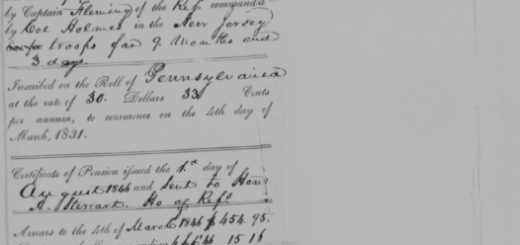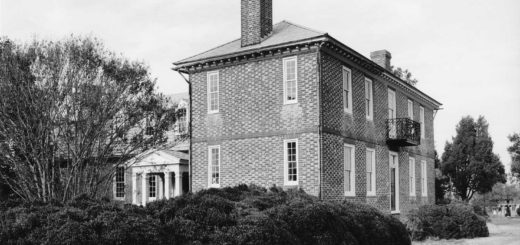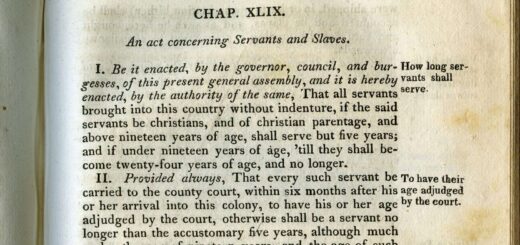Legacies of the Enslaved: Archaeology, Preservation, and New Discoveries at Patrick Henry’s Red Hill
Disclaimer: The thoughts and opinions of myself, the author, are my own and do not represent Patrick Henry’s Red Hill.
We are living in a time when historic interpretation, preservation, and stewardship are facing threats from without and within. Executive orders coming from the President of the United States are forcing some museums and institutions, such as the Smithsonian museums, to reevaluate how they present and interpret the history of slavery in our country. There has been much backlash to these orders from museum goers and numerous historians alike. Historians who have spoken out against the push to scale back the narrative of slavery, its history, and how we interpret it today include historians such as Heather Cox Richardson, Joseph McGill (The Slave Dwelling Project), Nicole Moore (Vice-President and President Elect of the National Council on Public History and Director of Education at Atlanta’s National Center for Civil and Human Rights), Bill Gwaltney (a historian with over 30 years of service with the National Park Service, Civil War historian, and Jack of all Trades in the field), and some of my own professors from my Alma Mater, Longwood University are weighing in on the topic.
These executive orders have also prompted some museums, associations, and institutions to issue statements in support of maintaining the accuracy of information and standards of the museum and history field. On August 7, 2025, the National Council on Public History issued a statement in regards to recent events, stating that “The administration’s directive ignores our field’s scholarship and the will of the American people, who have repeatedly said they want to explore the nation’s history in all of its depth and complexity. The directive removes crucial context that audiences need for a fuller understanding of the past and it relevance to today.” (Click here to read the full statement from the NCPH, https://ncph.org/news/ncph-signs-joint-statement-on-erasure-of-nps-sites/). In response to Executive Order 14253, the Organization of American Historians (OAH) expressed its concerns with the orders on August 14, 2025, saying:
“This correspondence and its underlying command represent an unacceptable instance of ongoing executive overreach, striking at the independence of one of our nation’s preeminent historical and cultural institutions…It is particularly distressing to see this effort of historical censorship and sanitizing tied to the 250th anniversary of the nation’s founding—what should be a moment for thoughtful reflection about and celebration of the American experiment with all its tragedies and triumphs.”
(Click here to see the full statement from the OAH, https://www.oah.org/2025/08/14/statement-on-the-white-house-review-of-the-smithsonian/)
President Trump posted on Truth Social on August 19, 2025, that “The Museums throughout Washington, but all over the Country are essentially, the last remaining segment of “WOKE.” In response to this on August 22, 2025, The Lincoln Heritage Museum in Lincoln, Illinois posted on their official Facebook page stating:
“Museums are centers of public history, who have a deliberate purpose to connect audiences with the past, so as to learn from both the successes and failures of that past and ponder the larger questions of history and how they apply to our world today. Museums are not places meant to make us feel comfortable nor to serve as echo chambers for a narrative so that we can feel good about ourselves and our history. They are not places to rest upon biases if those biases don’t possess historical accuracy. Museums have an ethical commitment to the historical truth, whether that truth be painful or pleasant. They should challenge our conventional thinking and beckon us to remake ourselves and our world around us a better place.”
A lot of museums and institutions who receive Federal funding have already been under the crosshairs; either comply or lose Federal funding. Here locally in the Richmond area, for example, the Black History Museum and Cultural Center of Virginia has lost Federal funding because of who they are and what they represent. PBS, NPR, CPB, IMLS, NEH, and other institutions have lost funding as well as a result of efforts to change the narrative of our nation’s history. It all comes down to the local and state museums who do not rely on Federal funding to continue these narratives.
Here in Virginia, there are numerous local and state museums who, in the face of these uncertain times, are continuing to research, preserve, interpret, and display narratives about the history of slavery at their sites. And these museums and historic sites deserve a debt of gratitude for having the courage to continue forward with their hard work. And it isn’t just small museums and sites. Larger organizations such as Monticello, Mount Vernon, Montpelier, Menokin, the Colonial Williamsburg Foundation, Preservation Virginia, and Jamestown Rediscovery, continue to carry the narrative of slavery at their sites.
Among the relevant sites and museums who are making great efforts at researching their legacy of slavery at their site is Patrick Henry’s Red Hill, in Brookneal, Virginia. Patrick Henry, born in 1736, was a self-taught lawyer, politician—Henry was a member of the Virginia House of Burgesses, a delegate to the Continental Congress, 1st and 6th Governor of Virginia, and a member of the Virginia House of Delegates—and orator, having been known as the voice of the American Revolution for having given his “Give Me Liberty or Give Me Death” speech. Henry purchased Red Hill from Richard Booker in 1794 and moved there shortly thereafter. He resided at Red Hill until his death on June 6, 1799, and is buried there in the Henry family cemetery, along with his second wife, Dorothea Dandridge Henry (she is actually an ancestor of mine). FUN FACT: Between his two marriages, Patrick Henry had 17 children, and 77 grandchildren!!! Red Hill would remain in the Henry family until 1944, when Lucy Gray Henry Harrison died. She was the last of the Henry’s who lived at Red Hill.
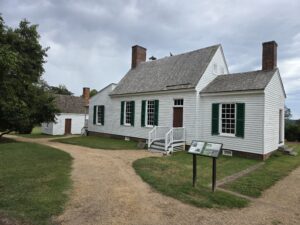
The Henry House at Red Hill, photo by Todd Long, August 2025.
On October 27, 1944, the Patrick Henry Memorial Foundation was established. In 1945, the Foundation purchased Red Hill from the estate of Lucy Harrison. As part of their mission, the Foundation, under the guidance of Lynchburg architect Stanhope Johnson, rebuilt the Henry family home and kitchen which were completed in 1957, and by 1961, Patrick Henry’s law office and other buildings were restored to how they looked in his day. Since their founding, The Patrick Henry Memorial Foundation and Red Hill have been excellent stewards of the memory of this most famed of Founding Fathers. But it has been in recent years that the Foundation has done some of its best work, under the leadership of current CEO, Hope Marstin.
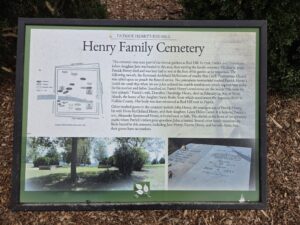
Interpretive sign at the Henry Family Cemetery at Red Hill, photo by Todd Long, August 2025.
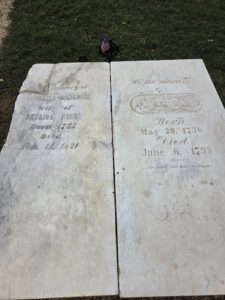
Graves of Patrick Henry and his second wife, Dorothea Dandridge Henry, photo by Todd Long, August 2025.
It is without a doubt that Patrick Henry was a great man and accomplished many great things. A talented lawyer, he taught himself law and was involved in many high-profile cases, including the Parson’s Cause court case. As a gifted orator with an ability to spark a fire in those who heard him speak, he lit the flame within many colonists to seek independence from Great Britain when he gave his famous “Give me liberty or give me death” speech at St. John’s Church in Richmond in the presence of the Second Virginia Convention on March 23, 1775. As a politician, he served Virginia in the Continental Congress, the Governor’s seat, and Virginia’s House of Delegates. Despite all the great things Henry did, he was still a flawed human. Like many men of his time, he was an enslaver of other human beings. Thus is the great paradox of American history. And the same can be said for many of our Founding Fathers. How could a man who championed liberty and independence, also be a slave owner? It is known that Patrick Henry struggled with the paradox of championing liberty while denying others theirs. One of the few instances that Henry shared his feelings on the institution of slavery was in a letter he sent to a friend, Robert Pleasants on January 18, 1773:
Dear Sir. Hanover January 18th . 1773
I take this opportunity to acknowledge the Recet: of Anthoy . Bennezet’s Book against the Slave Trade. I thank you for it.
It is not a little surprizing that Christianity, whose chief Excellence consists in softening the human Heart, in cherishing and improving its finer feelings should encourage a practice so totally repugnant to the first Impressions of Right and wrong, what adds to the wonder is that this abominable Practice has been introduced in the most enlightened Ages. Times that seem to have Pretensions to boast of high Improvements in Arts, Sciences and refined Morality, have brought into general Use and guarded by many Laws a species of Violence and Tyranny which our more rude and barbarous, but honest Ancestors detested. Is it not amazing, that at a time when the rights of Humanity are defined and understood with precision; in a Country above all others fond of Liberty, that in such an Age and such a Country we find Men professing a Religion the most humane, mild, meek, gentle and generous, adopting a principle as repugnant to humanity as it is inconsistent with the Bible and destructive to Liberty. Every thinking honest man rejects it in Speculation; how few in Practice From conscientious Motives? The World in general has deny’d your People a Share of its Honors, but the wise will ascribe to you a just Tribute of virtuous praise for the practice of a Train of Virtues, among which your Disagreement to Slavery will be principally ranked. I cannot but wish well to a people whose System imitates the Example of him whose Life was perfect, and believe me I shall honor the Quakers for their noble Effort to abolish Slavery.
It is equally calculated to promote moral and political Good.
Would any one believe that I am Master of Slaves of my own purchase? I am drawn along by the general Inconvenience of living without them. I will not, I cannot justify it. However culpable my Conduct, I will so far pay my Devoir to Virtue as to own the Excellence and Rectitude of her precepts, and to lament my want of Conformity to them.
I believe a time will come when an Opportunity will be offered to abolish this lamentable Evil, every thing we can do is to improve it, if it happens in our Day, if not let us transmit to our Descendants together with our Slaves, a pity for their unhappy Lot and an abhorrence for Slavery—If we cannot reduce this wished for Reformation to practice let us treat the unhappy Victims with Lenity, it is the farthest Advance we can make towards Justice, it is a Debt we owe to the purity of our Religion, to shew that it is at Variance with that Law which warrants Slavery.
Here is an Instance that Silent meetings (the Scoff of reverend Doctors,) have done that which learned and elabourate preaching could not effect, so much preferable are the genuine Dictates of Conscience and a steady Attention to its feelings above the Teachings of those Men who pretend to have found a better Guide.
I exhort you to persevere in so worthy a Resolution, some of your People disagree, or at least are lukewarm in the Abolition of Slavery, many treat the Resolution of your Meeting with Ridicule, and among those who throw Contempt on it are Clergymen, whose surest Guard against both Ridicule and Contempt is a certain Act of Assembly.
I know not whereto stop. I could say many things on this Subject, a serious Review of which gives a gloomy perspective to future times. Excuse this Scrawl, and believe me with Esteem your humble Servant
Patrick Henry junr.
Many books and articles have been published covering the life of Patrick Henry. But what of those who were enslaved by him and labored for him at Red Hill? When Patrick Henry married his first wife, Sarah Shelton, in 1754, as part of her marriage dowry, they were given six enslaved people. By the time of his death in 1799, Henry owned at least 70 enslaved people as noted in his estate inventories.
Red Hill’s first efforts at preserving the history of the enslaved on the historic property came in 1961 when the Foundation restored Harrison’s Cabin, using about one-quarter of its original logs. Harrison’s Cabin was the home of Harrison Henry, an enslaved man owned by Patrick Henry. Harrison, born in 1798, was the son of Critty, the likely cook for the Henry family at Red Hill. Harrison lived to see emancipation with the ending of the Civil War in 1865. Following Harrison’s emancipation, William Wirt Henry, grandson of Patrick Henry, gave the cabin to him and a small plot of land at Red Hill. Harrison Henry would live to the ripe old age of 108, dying in 1906! Both outside and inside of the cabin are interpretive signs discussing Harrison Henry, the use of the lower and upper floor of the cabin and is set up as it would have likely looked when Harrison lived there as a free man.
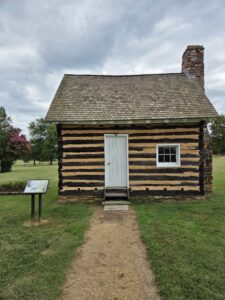
Harrison’s Cabin at Red Hill, photo by Todd Long, August 2025.
The current kitchen at Red Hill is a reconstruction of what would have likely been at Red Hill in Patrick Henry’s time. As the probable cook at Red Hill, Critty would have spent many long hours in the kitchen, planning, and cooking meals for the Henry family and any of its visitors. The loft above the kitchen would have housed Critty and her three children, Jack White, Harrison, and Coleman. The kitchen is outfitted with examples of the types of food cooked there, the utensils used to prepare the Henry family meals, and common furniture used in a kitchen of the period by the enslaved cooks who lived at Red Hill.

Interior of the kitchen at Red Hill, photo by Todd Long, August 2025.
A New Legacy begins
In 2018 Red Hill received a grant from the Heid Trust, in which they were able to purchase the enslaved cemetery on Quarter Place as well as 77 acres surrounding the cemetery. This land was named the “Quarter Place” by Patrick Henry because of the numerous enslaved quarters on the site. The following year, Hope Marstin was named Red Hill’s first female Chief Executive Officer. The grant and new leadership enabled the story of Red Hill’s enslaved community to start being told and has led to the forging of a new legacy at Red Hill.

Interpretive sign at the Quarter Place Cemetery at Red Hill, photo by Todd Long, August 2025.
Hope and the Red Hill Board of Directors have worked hard to make these narratives and stories come to life by bringing on the right people, at the right time, to carry forward its mission of telling these stories. Without all the staff of Red Hill, interpreting, telling, and sharing the stories of the enslaved would not be possible. When Hope Marstin started working in a part-time position at Red Hill in 2009, there were only 2 full-time staff members, and 5 part-time staff. Today, Red Hill has 9 full-time staff members and 9 part-time. Each of the staff members of Red Hill deserve a well earned thank you and round of applause from the historic community, local and state community, and descendant community: Melissa Carwile (Director of Operations), Caitlin Curtis Olsen (Director of Education and Donor Systems), Cody Youngblood (Director of Historic Preservation & Collections), Lucia Butler and Margaret Dudley (Staff Archaeologists), Sydney Scotford (Marketing Coordinator and Social Media Manager), Michelle Seddon (Community Engagement Coordinator), Cindy Smith (Administrative Support Specialist), Stacy Strickland (Gift Shop Manager), Peighton Young (Historian and Genealogist of African American History), Bruce Olsen (Director of Grounds and Maintenance), Jarret Olsen (Groundskeeper), Patrick Henry Jolly (Patrick Henry Descendant and Researcher), Courtney Hollingsworth (Visitor Center Associate), Ethan Purita (Visitor Center Associate), Mark Couvillon (Patrick Henry Scholar and author of several books related to Patrick Henry), and Cole Poindexter (Henry Family Genealogist).
The topic of slavery at historic sites is a sensitive and hard topic and must be told correctly and honestly to honor the ancestors properly. To learn how to tell the story of the enslaved of Red Hill with proper respect staff members visited numerous historic sites around Virginia to learn how other sites researched, interpreted, and told their stories of the enslaved at those sites.
Genealogy and the descendant community at Red Hill
One aspect that Red Hill has really been expanding on is its inclusion of the descendant community. With the goal of research, teaching, and public history initiatives, the Research Advisory Committee advises the Patrick Henry Memorial Foundation on the work centered around Patrick Henry, the Henry family, and the enslaved and free people at Red Hill. One person I would like to highlight who has been a big mover of much of the narrative around the enslaved and free community of Red Hill is Peighton Young.
Peighton started working at Red Hill in April 2020 after Hope Marstin came across their work on historical research of the enslaved and post-slavery Black community at Bacon’s Castle, a site owned by Preservation Virginia. Peighton holds a B.A. in Art History from Virginia Commonwealth University (VCU), two M.A.’s in History (from both VCU and the College of William & Mary), and is currently a PhD student at William & Mary. As many of Red Hill’s staff do, Peighton wears many hats. Peighton is Red Hill’s Historian and Genealogist of African American History. Much of what Peighton does is centered around the Quarter Place project encompassing the history of the enslaved and free Black community that resided at Red Hill. Peighton started the African American research and genealogical programming at Red Hill. In addition to all of that, Peighton is also responsible for identifying all those who were buried in the Quarter Place Cemetery. To date, 147 people have been discovered in the cemetery and 60 of those burials have been identified; Peighton also created a spreadsheet for those who have been identified (https://www.redhill.org/wp-content/uploads/2025/06/Quarter-Place-Burials.pdf). I had the opportunity to ask Peighton a series of questions through email in regard to their work at Red Hill. When I asked Peighton about how their research and discoveries influenced their work there, they had this to say:
I created Red Hill’s African American research and genealogical program, and currently manage its cemetery research, so my work is pretty much entirely focused on trying to reconstruct the history of Black life, not just at Red Hill, but at all historical sites and localities connected to those who were enslaved on the plantation. With that, has come a big responsibility of working to shift how Red Hill educates the public about the history of human life at Red Hill – homing in on the importance of understanding that plantations are sites of immense human interaction and experiences, with each person or community on its’ strata contributing the history of the space in their own distinct ways. I work to ensure Red Hill remains accountable to the descendants of the enslaved and the post-slavery Black community who lived on-site after Emancipation in how we prioritize telling their stories in Red Hill’s larger narrative. I’m not sure if I would say that the research or anything I have discovered as influenced my work or how I go about doing my research necessarily, but I am grateful for the steadfast commitment African American descendants have had to advocating on behalf of ensuring that Red Hill memorializes and educates the public about their ancestors, properly. I am continuously in awe of how invested they are in keeping our research efforts alive and I’m grateful that we, as an organization, have the opportunity to create space for descendants to visit the grounds their relatives were once bound to, highlight the persistence and longevity of their family lines – which their ancestors fought so hard to preserve throughout slavery through the Jim Crow Era, and tell their ancestors’ stories in ways that that descendants find meaningful.
Since 2022, Red Hill has hosted an annual Quarter Place Tribute for the descendants of those who were once enslaved at Red Hill. This year’s Annual Quarter Place Tribute will take place at Red Hill on October 4, 2025, from 11AM until 3:30PM. Events included are an opening ceremony at the Quarter Place Cemetery, presentations, genealogy updates, and interactions with partner museums, organizations, and vendors.
Historic Preservation and Collections
Historic preservation and collections are two important aspects of any historic site. It is an absolute necessity to have an able person to handle both. Preservation of a site’s structures, cemeteries, and collections is an important task. Historic buildings and cemeteries require constant upkeep and need the keen eye of someone with experience and education in the conservation of them. Collections are also important because documents and artifacts tell much of the story of a site, the people who lived there, and the events that occurred at a site.
Cody Youngblood is Red Hill’s Director of Historic Preservation and Collections. Holding a B.A. in Historic Preservation and Museum Studies from the University of Mary Washington and an M.A. in the Conservation of Historic Buildings from the University of York, Cody has done an excellent job of preservation at Red Hill, including preserving the Quarter Place Cemetery and grounds of the Quarter Place. In addition to that, Cody has done an excellent job preserving and maintaining the more than 3,000 artifacts and documents, including documents and artifacts relating to the enslaved who lived at Red Hill.
Hope Marstin states that, “When I started [at Red Hill], we kept everything in a tiny vault and in no order whatsoever. We also had a lot of items which were on loan. Since Cody Youngblood took over the collections, it is now well organized, properly kept and we have a policy in place going forward.”
On Wednesday, August 27, 2025, Red Hill had a ribbon cutting event, signaling the opening of its new Administration and Research Building. At this event, guests were able to see for the first time the Edith C. Poindexter Collections Rooms, the Peggy P. Bowen Archaeology Lab, and the Smith-McDowell Meeting Room.
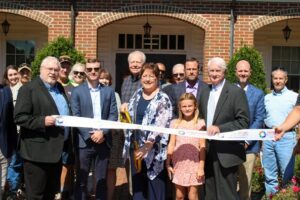
Ribbon Cutting for the new Administration and Research Building at Red Hill, photo courtesy of Red Hill, August 27, 2025.
The Quarter Place Cemetery
Located about a half mile from the Visitor Center, is the Quarter Place Cemetery. Cemeteries for the enslaved were typically located a significant distance from the main house at historic sites, out of view of enslavers. After having acquired the Quarter Place property in 2018, Red Hill contacted Dr. Brian Bates of Longwood University and formed a partnership, to investigate the Quarter Place Cemetery. In early 2019, Dr. Bates conducted a LiDAR survey of the cemetery. The use of LIDAR technology has reshaped archaeology by using laser pulses to create high-resolution 3D mapping of landscapes to reveal hidden cultural features, settlements, and structures without having to perform destructive excavations.
The survey discovered the location of 147 graves of enslaved and freed Black people who resided and labored at Red Hill. Through research, approximately 60 individual graves have been identified. Only one grave in the Quarter Place Cemetery has an inscribed gravestone, the grave of Matilda Pannell. Born in April 1861, Matilda was enslaved at Red Hill until emancipation at the conclusion of the Civil War in 1865. Most of the other graves are only marked by field stones. Enslaved people and newly freed Black residents at Red Hill could not afford the costly price of headstones. Critty, the enslaved cook at Red Hill, is also one of the graves that have been identified in the Quarter Place Cemetery.

Grave of Matilda Pannell at the Quarter Place Cemetery at Red Hill, photo by Todd Long, August 2025.
One day when I was volunteering at Red Hill with their archaeology team on the Quarter Place cabin site, I walked down to the cemetery on our lunch break. Being in a hallowed place such as this is a very somber and sobering experience. There is a sadness to it, but in this case, there is also comfort in that the ancestors are being found, their stories coming to life. And if you sit down there on the bench in the cemetery, and just listen quietly, you can hear the echo of their voices.

Fieldstones marking the locations of graves at the Quarter Place Cemetery at Red Hill, photo by Todd Long, August 2025.
Archaeology of the enslaved at the Quarter Place site
Red Hill began its archaeology program in the Summer of 2023—with the guidance of consulting archaeologists Dr. Brian Bates of Longwood University and Craig Rose of Dominion Research Group—with an investigation of the location of a servant’s house located a few hundred feet to the northwest of the Henry House. To lead the new archaeology program, Red Hill appointed Lucia Butler, who had started working at Red Hill in 2021, as a Staff Archaeologist. Lucia has a B.A. in Anthropology from the College of William and Mary in Williamsburg. She also attended the Dr. James W. Jordan Archaeology Field School at Longwood University. The archaeological investigation at the servant’s house site yielded artifacts such as bricks and brick fragments, glass, nails, ceramics, some prehistoric lithic material, two metal hooks, buttons, a bottle neck with a glass stopper, a sink drain, and several unidentified metal objects. Artifacts such as these tell a story. Personal items tell of the things that were important individuals. Artifacts such as ceramics, glass, nails, lithic materials, and metallic objects can help date a site and show how people lived on a site.
A new addition to the archaeology team at Red Hill is Margaret Dudley, a Staff Archaeologist and a 2025 graduate of Longwood University, with a B.S. in Anthropology and Archaeology and a minor in Psychology. Both Lucia and Margaret are a dream team who work hard to bring new discoveries of the enslaved community of Red Hill to the forefront.
In 2024, the archaeology team investigated the original location of Patrick Henry’s law office which was located in the back yard of the Henry House which originally faced south in the direction of the Staunton River. Artifacts found at this site included bricks and brick fragments, creamware and whiteware ceramic sherds, bottle glass, windowpane glass, cut nails, and small fragments of mortar.
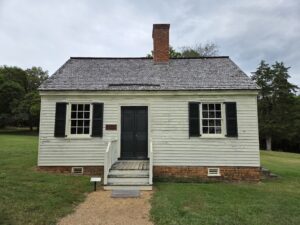
Patrick Henry’s reconstructed law office at Red Hill, photo by Todd Long, August 2025.
One day in August 2025, being a follower of Red Hill’s Facebook page, I saw an advertisement they put out seeking out volunteers for their archaeology program. Having a B.A. in History from Longwood University myself, and a semester of the Dr. James W. Jordan Archaeology Field School under my belt, I jumped at the opportunity to volunteer at Red Hill.
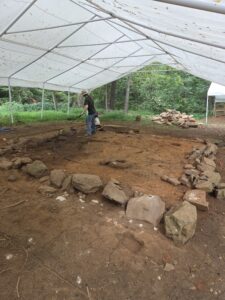
Foundation of the west cabin at Red Hill’s Quarter Place site, photo by Todd Long, August 2025.
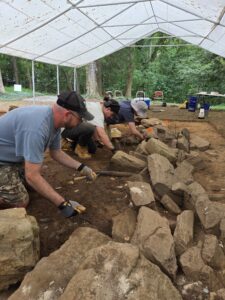
Todd Long, Savey Lombardo, and Margaret Dudley excavating the west cabin foundation at Red Hill’s Quarter Place site, photo by Lucia Butler, August 2025.
On a couple of days off from my regular job, I trekked two hours from the Richmond area where I live, to assist in the excavation of one of the two enslaved cabin foundations that Red Hill’s archaeology team spent the summer working on. The cabin that I took part in the excavation of was the western cabin foundation. Artifacts we discovered included some 19th and early 20th century coins, pieces of mortar, cut and round nails, bottle and window glass, various pieces of ceramics, some lithic material, a porcelain arm from a doll, shell buttons, and even modern artifacts such as a vehicle decal for AAA.
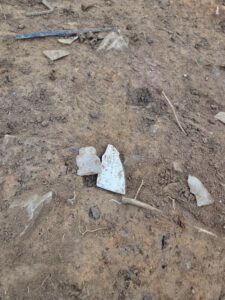
Lithic and ceramic artifacts excavated at the Quarter Place site, photo by Todd Long, August 2025.
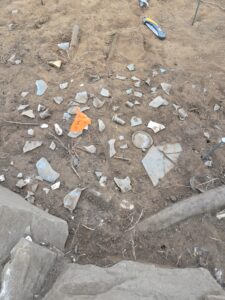
Artifact assemblage at the west cabin foundation on Red Hill’s Quarter Place site, photo by Todd Long, August 2025.
For the remainder of the year, I plan on going back to assist in their new archaeology lab. As a Longwood alumnus myself, I am also proud to see my old alma mater being represented at Red Hill so significantly, as a number of staff there are graduates of Longwood. Go Lancers!!! The archaeology team also had ten current Longwood students and alumni and one intern from the University of Tennessee Knoxville—they were employed by Red Hill as field technicians—there conducting fieldwork over the summer.
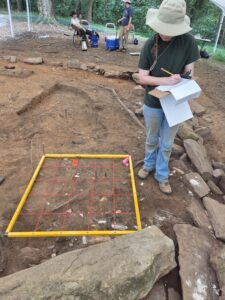
Lucia Butler grid mapping the locations of artifacts at the Quarter Place site, photo by Todd Long, August 2025.
Other structures on Quarter Place
At the beginning of the Quarter Place trail is a reconstructed enslaved cabin that house the exhibit, The Price of Chains & Slavery: Enslavement, Jim Crow, and the Black experience at Patrick Henry’s Red Hill. The cabin exhibit is an excellent starting point for Quarter Place in that it tells the story of those who were enslaved there and later lived there as free sharecroppers. Complete with panels telling some of individual stories of those who lived at Quarter Place, the exhibit also features a general overview of the history of slavery in Virginia and displays some of the artifacts found through archaeological excavations at Red Hill.
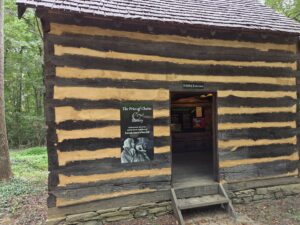
The Price of Chains & Slavery cabin exhibit at the Quarter Place, photo by Todd Long, August 2025.
Down the hill a few hundred yards from the foundations of the enslaved cabins is an original tobacco barn where tobacco was cured by being hung over wooden sticks inside the barn for 4 to 6 weeks. In Patrick Henry’s time, over 20,000 pounds of tobacco left Red Hill in barrels called hogsheads and were sent down the Staunton River to markets in Lynchburg and Richmond.
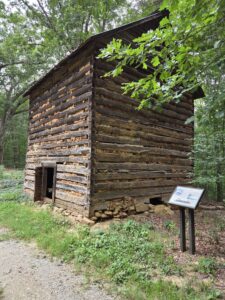
The tobacco barn at the Quarter Place, photo by Todd Long, August 2025.
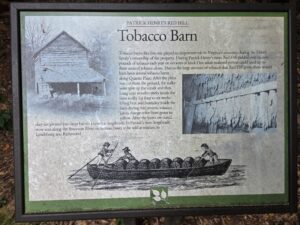
Tobacco barn interpretive sign at the Quarter Place.
Nearby the tobacco barn is an ordering pit that was used by the enslaved people of Red Hill. An ordering pit was a covered, dirt-floored cellar, where cured tobacco was placed to make more pliable.
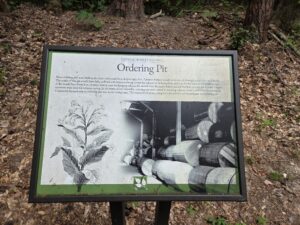
Ordering pit interpretive sign at the Quarter Place.
Why does this all matter
The efforts of all the staff at Red Hill to research, discover, and tell the stories of those who were once enslaved there have been beyond exceptional. It is not just one person who deserves credit, but a village of people who have a vision, desire, and yes, even courage to tackle a narrative that can be difficult. All the staff at Patrick Henry’s Red Hill each play an important role to ensure that the history of the site and its people—whether white, Black, or Native American—are equally and fairly represented. They have made sure the stories of people such as Critty, Harrison Henry, Matilda Pannell, and George Ed Britton have come to life, while also maintaining the legacies of the Henry family.
I feel that all who love history should visit Patrick Henry’s Red Hill, for a number of reasons. One, to learn about the life and the man who was the voice of the Revolution. His life and endeavors are the story of the greatness that became the United States. Although he was key to the founding of the nation, Henry was torn on the subject of slavery. He knew and felt the injustice of the practice, but as many in his time, he did not see a way to live without enslaved people, though he hoped for a future solution that would eventually see those bound to a life of service, freed. Visiting this site will help people see the many facets of Patrick Henry and not just the known history.
Second, visiting this site allows visitors to see history happening in real time by observing archaeology as it happens and having the ability to see objects that have not seen the light of day in many generations.
Most importantly, people should come to see Red Hill to learn about those who were enslaved there; after all, without them, Red Hill may not have existed. Their story is America’s story. It may have been a dark time in our history, but the enslaved went on to have families and their descendants can now come to a place where they can learn about where they came from and see what they have accomplished over the generations and pay homage to the ancestors and see their final place of rest. Red Hill has a history that goes back thousands of years. The artifacts, documents and collections offer visitors something tangible to see that sheds light on the ancient lives of the native tribes who inhabited Red Hill before European contact, the objects that were used and meant something to both the Henry family and those who were enslaved there.
Why does this all matter? I have my thoughts on this, but I feel it is best to refer this question to those who are discovering these narratives and are presenting this history. I asked both Hope Marstin and Peighton Young why it is important for historic sites such as Red Hill, include the narrative of the enslaved communities. Hope’s answer was simple and straightforward: “Why is it important? It is history, we tell history here, all Red Hill’s history. It is important not to forget any of Red Hill’s history.” In response to this question Peighton had this to say: “If a site in not including such narratives, then they’re not telling the full history of the space. Further, they’re perpetuating the historical silences that have served to try and erase the histories and experiences of enslaved people for generations. It is our responsibility, as museum and education professionals, to create an environment in which visitors learn about all facets of our site’s history – not just the history of the white families who owned the land.” I also asked Lucia Butler at the end of the above video on the archaeology at the Quarter Place cabins, to elaborate on the importance of including the narratives the enslaved communities. She had this to say: “It’s important to tell their stories because they lived here and they contributed to what Red Hill is and they are part of its history.”
Check out the Red Hill website often, as they have many events on the calendar throughout the year, www.redhill.org. Check their volunteer calendar and pop on over and help out for a day with something you may find interesting.
References
Henry, Patrick. Patrick Henry to Robert Pleasants, January 18, 1773. In Patrick Henry’s Speeches & Writings, https://www.redhill.org/speeches-writings/.
Hope Marstin, e-mail message to author, September 2, 2025.
Peighton Young, e-mail message to author, September 4, 2025.
Red Hill. “History of Red Hill.” Accessed September 5, 2025. https://www.redhill.org/red-hill/.
Red Hill. “Red Hill Archaeology.” Accessed September 3, 2025. https://www.redhill.org/archaeology/.
Red Hill. “Research Advisory Council & Community Engagement Committee.” Accessed September 7, 2025. https://www.redhill.org/committees/.
Red Hill. “Quarter Place.” Accessed September 6, 2025. https://www.redhill.org/quarter-place/.
